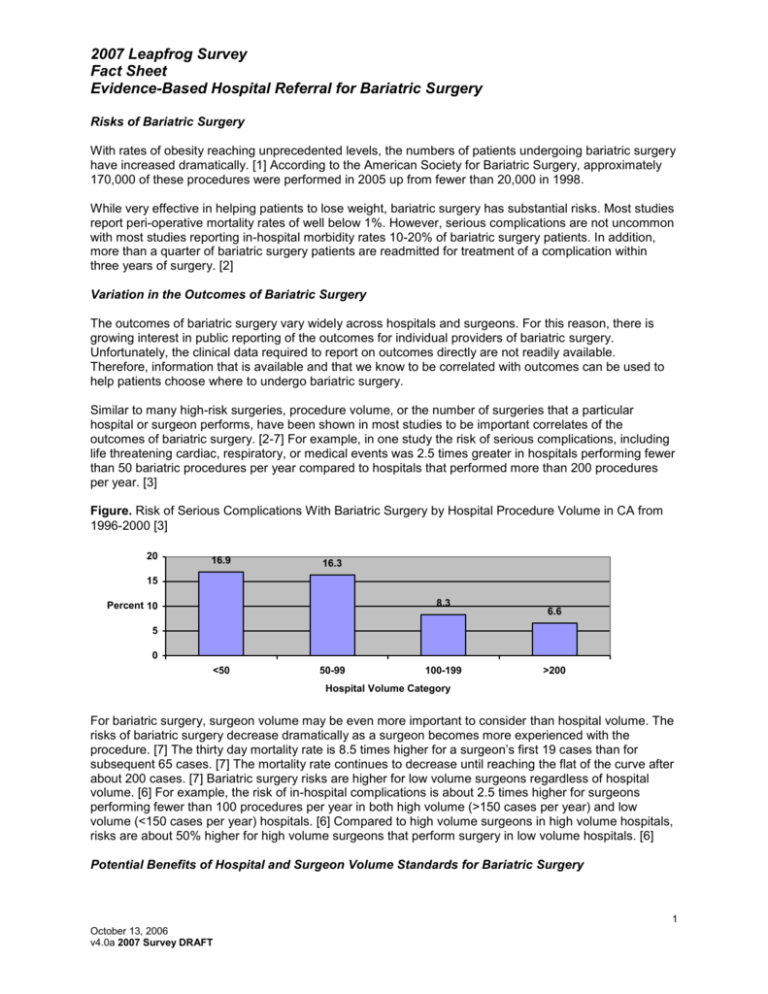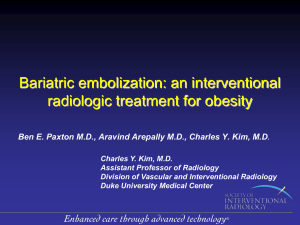Fact Sheet: Bariatric Surgery
advertisement

2007 Leapfrog Survey Fact Sheet Evidence-Based Hospital Referral for Bariatric Surgery Risks of Bariatric Surgery With rates of obesity reaching unprecedented levels, the numbers of patients undergoing bariatric surgery have increased dramatically. [1] According to the American Society for Bariatric Surgery, approximately 170,000 of these procedures were performed in 2005 up from fewer than 20,000 in 1998. While very effective in helping patients to lose weight, bariatric surgery has substantial risks. Most studies report peri-operative mortality rates of well below 1%. However, serious complications are not uncommon with most studies reporting in-hospital morbidity rates 10-20% of bariatric surgery patients. In addition, more than a quarter of bariatric surgery patients are readmitted for treatment of a complication within three years of surgery. [2] Variation in the Outcomes of Bariatric Surgery The outcomes of bariatric surgery vary widely across hospitals and surgeons. For this reason, there is growing interest in public reporting of the outcomes for individual providers of bariatric surgery. Unfortunately, the clinical data required to report on outcomes directly are not readily available. Therefore, information that is available and that we know to be correlated with outcomes can be used to help patients choose where to undergo bariatric surgery. Similar to many high-risk surgeries, procedure volume, or the number of surgeries that a particular hospital or surgeon performs, have been shown in most studies to be important correlates of the outcomes of bariatric surgery. [2-7] For example, in one study the risk of serious complications, including life threatening cardiac, respiratory, or medical events was 2.5 times greater in hospitals performing fewer than 50 bariatric procedures per year compared to hospitals that performed more than 200 procedures per year. [3] Figure. Risk of Serious Complications With Bariatric Surgery by Hospital Procedure Volume in CA from 1996-2000 [3] 20 16.9 16.3 15 8.3 Percent 10 6.6 5 0 <50 50-99 100-199 >200 Hospital Volume Category For bariatric surgery, surgeon volume may be even more important to consider than hospital volume. The risks of bariatric surgery decrease dramatically as a surgeon becomes more experienced with the procedure. [7] The thirty day mortality rate is 8.5 times higher for a surgeon’s first 19 cases than for subsequent 65 cases. [7] The mortality rate continues to decrease until reaching the flat of the curve after about 200 cases. [7] Bariatric surgery risks are higher for low volume surgeons regardless of hospital volume. [6] For example, the risk of in-hospital complications is about 2.5 times higher for surgeons performing fewer than 100 procedures per year in both high volume (>150 cases per year) and low volume (<150 cases per year) hospitals. [6] Compared to high volume surgeons in high volume hospitals, risks are about 50% higher for high volume surgeons that perform surgery in low volume hospitals. [6] Potential Benefits of Hospital and Surgeon Volume Standards for Bariatric Surgery 1 October 13, 2006 v4.0a 2007 Survey DRAFT 2007 Leapfrog Survey Fact Sheet Evidence-Based Hospital Referral for Bariatric Surgery If all of the 170,000 bariatric surgery patients were to receive surgery in hospitals that perform at least 100 bariatric procedures annually, more than 3,000 serious complications would be avoided each year. Even larger improvements in the outcomes of bariatric surgery would result if all patients were to have a high volume surgeon. In addition to the benefits measured in terms of patient suffering, reducing the numbers of bariatric complications would result in substantial financial savings. By one estimate, healthcare payments exceed $65,000 for patients readmitted for complications in the 6 months following bariatric surgery compared to about $25,000 for those who do not have complications. [8] The Leapfrog Volume Standards for Bariatric Surgery Under the advisement of national experts in bariatric surgery and quality improvement, the Leapfrog Group has adopted the following volume standards for bariatric surgery. Rating Full Credit Good Progress Good Early Stage Exempt Standard Annual hospital volume >100 with no low volume (<20 cases annually) surgeons Annual hospital volume >50 OR >100 with one or more low volume surgeons Participates in ACS NSQIP or ACS database, but report is not yet available New (<2 years) bariatric programs Challenges Most hospitals do not meet these volume standards for bariatric surgery. [9] While, high volume hospitals should be able to absorb the relatively minor increase in case loads that minimum volume standards would bring about, it is unknown what kind of geographic barriers there would be to regionalizing bariatric surgery. Furthermore, it is not known how many surgeons meet the >50 procedures per year standard. We have exempt new bariatric programs from the standards in order to allow time for these programs volumes to stabilize as they become established. 2 October 13, 2006 v4.0a 2007 Survey DRAFT 2007 Leapfrog Survey Fact Sheet Evidence-Based Hospital Referral for Bariatric Surgery References 1. 2. 3. 4. 5. 6. 7. 8. 9. Santry, H., D. Gillen, and D. Lauderdale, Trends in bariatric surgical procedures. Journal of the American Medical Association, 2005. 294(15): p. 1909-1917. Zingmond, D., M. McGory, and C. Ko, Hospitalization before and after gastric bypass surgery. Journal of the American Medical Association, 2005. 294(15): p. 1918-1924. Liu, J., et al., Characterizing the performance and outcomes of obesity surgery in California. The American Surgeon, 2003. 69(10): p. 823-828. Courcoulas, A., et al., The relationship of surgeon and hospital volume to outcome after gastric bypass surgery in Pennsylvania: A 3-year summary. Surgery, 2003. 134(4): p. 613-623. Nguyen, N., et al., The relationship between hospital volume and outcome in bariatric surgery at academic medical centers. Annals of Surgery, 2004. 240(4): p. 586-594. Weller, W. and E. Hannan, Relationship between provider volume and postoperative complications for bariatric procedures in New York State. Journal of the American College of Surgeons, 2006. 202(5): p. 753-761. Flum, D. and E. Dellinger, Impact of gastric bypass operation on survival: A population-based analysis. Journal of the American College of Surgeons, 2004. 199(4): p. 543-551. Encinosa, W., et al., Healthcare utilization and outcomes after bariatric surgery. Medical Care, 2006. 44(8): p. 706-712. Birkmeyer, N., et al., Characteristics of hospitals performing bariatric surgery. Journal of the American Medical Association, 2006. 295(3): p. 282-284. 3 October 13, 2006 v4.0a 2007 Survey DRAFT





